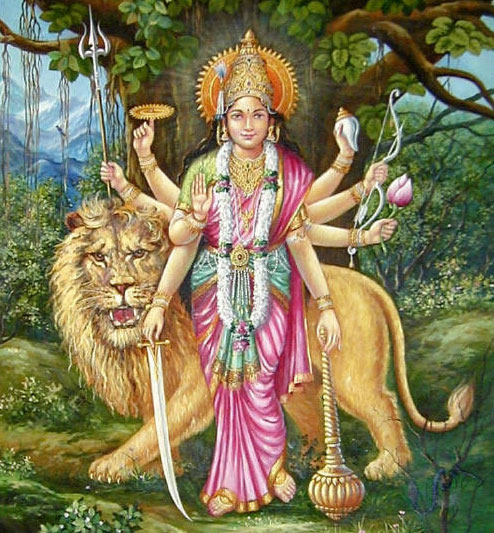
Durga
Durga, in Sanskrit means “She who is incomprehensible or difficult to reach.”
Goddess Durga is a form of Sakti worshiped for her gracious as well as terrifying aspect. Mother of the Universe, she represents the infinite power of the universe and is a symbol of a female dynamism. The manifestation of Goddess Durga is said to emerge from Her formless essence and the two are inseparable.
She is also called by many other names, such as Parvati, Ambika, and Kali. In the form of Parvati, She is known as the divine spouse of Lord Shiva and is the mother of Her two sons, Ganesha and Karttikeya, and daughter Jyoti. Destroyer of demons, she is worshiped during an annual festival called Durga puja, especially popular among Bengalis.
Her Appearance
There are endless aspects of Durga described in the Puranas and Agamas and the iconography is consequently very varied. She is usually pictured as having ten arms holding Sword, Conch, Discus, Rosary, Bell, Winecup, Shielf, Bow, Arrow, and Spear. She is most often shown riding a lion from which comes Her august name, Simhavahini, “She who stands astride the king of beasts”. She is gorgeously dressed in royal red cloth and has several ornaments decorating Her personage. Her hair is dressed up in a crown (karandamukuta) which then flows out in long luxuriant tresses that are darkly luminous and soothing to the eye. The various tools reflects the eminent supremacy that helps in controling the universe and obey Her will.
Weilding Energy
Goddess Durga exists eternally, always abiding in her own sweet nature and inhabits the hearts and minds of her ecstatic devotees. As Shakti power, she shapes, nurtures, and dissolves names and forms, while as subtle spiritual energy called Kundalini, She lights the lotuses fo the seven centres of awareness in the sacred human body. Goddess Durga killed the powerful demon Mahish and all his great commanders. When demonic forces create imbalance all god unite becoming one divine force called Shakti or Durga.
Origin of Durga – The Mythology
Durga, a beautiful warrior seated upon a tiger.
Devi is the great goddess of the Hindus,the consort of Shiva and she is worshiped in various forms corresponding to her two aspects: benevolence and fierceness. She is Uma, “light”; Gauri, “yellow or brilliant”; Parvati, “the mountaineer”; and Jagatmata, “the-mother-of-the-world” in her milder guise. The terrible emanations are Durga “the inaccessible”; Kali, “the black”; Chandi, “the fierce”; and Bhairavi, “the terrible.”
Descent of the Goddess
Durga, a beautiful warrior seated upon a tiger, was the first appearance of the great goddess. The circumstance of her miraculous arrival was the tyranny of the monster-demon Mahishasur, who through terrific austerities had acquired invincible strength. The gods were afraid of this water-buffalo bull because neither Vishnu nor Shiva could prevail against him. It seemed that the joint energy of Shakti was only capable of vanquishing Mahisha, and so it was the eighteen-armed Durga who went out to do battle.
Battlefield
She went to battle on her ferocious mount lion, armed with the weapons given to her by the other Gods. Durga is one of the angry and aggressive aspects of the goddess Shakti, whose role in Hindu mythology was to fight and conquer demons and also personify the Sakti or female aspect of any male deity. In the battle, she fought and killed the evil Mahishasura and restored heaven to the Gods. Since then the goddess is invoked for protection from the powers of evil. Durga Puja is observed in her honor, to celebrate her victory over evil.
Revered Mother
She has been worshiped from about 400 AD, but probably earlier, to the present. Her literary references are chiefly the Ramayana and Mahabharata, epic and Puranic texts, and she is mentioned by name in Vedic literature. In general, Durga is regarded in northern India as the gentle bride epitomizing family unity while in southern India she is revered more in her warrior aspect.
Source www.durga-puja.org
Mataji Na Mantra
Ambikaye namo namah
Arasuri Maa namo namah
Vyagheshwari Maa namo namah
Aum Aim Hrim Klim namo namah
Vindhyavasini namo namah
Gabbar nivasini namo namah
Shailvasini namo namah
Aum Aim Hrim Klim namo namah
Chakradharini namo namah
Trishuldharini namo namah
Khhappardharini namo namah
Aum Aim Hrim Klim namo namah
Khdagadharini namo namah
Ashtradharini namo namah
Shastradharini namo namah
Aum Aim Hrim Klim namo namah
Brahmarupa namo namah
Vishvarupa namo namah
Gyaanrupa namo namah
Aum Aim Hrim Klim namo namah
Mahadevi namo namah
Durgadevi namo namah
Vishwadevi namo namah
Aum Aim Hrim Klim namo namah
Mahadevi namo namah
Mahavidhya namo namah
Mahamedha namo namah
Aum Aim Hrim Klim namo namah
Mayureshvari Maa namo namah
Kukuteshvari Maa namo namah
Sinheshvari Maa namo namah
Aum Aim Hrim Klim namo namah
Bagalamukhi namo namah
Rudramukhi namo namah
Soumyamukhi namo namah




